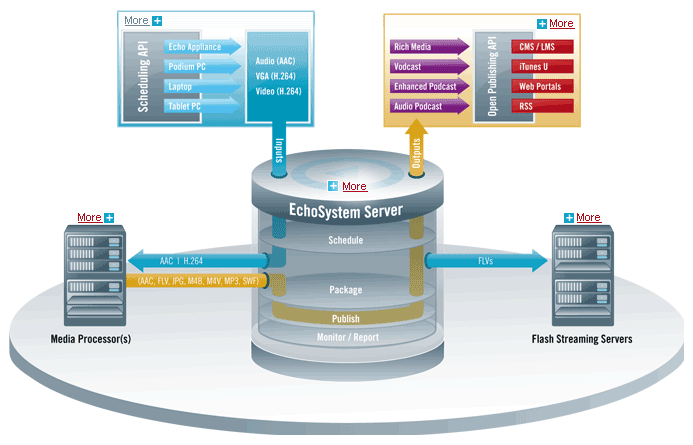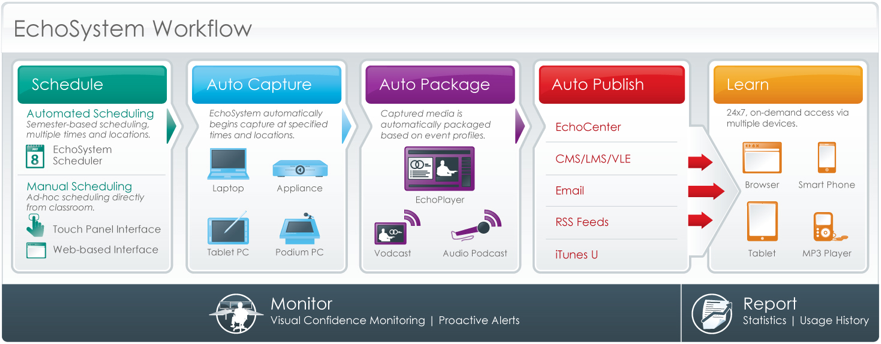In this section:
A high-level overview of the EchoSystem including architecture, components, workflow, functionality and major features. |
In this section: |
The EchoSystem is a complete, fixed classroom, mobile, and faculty lecture capture solution for deployment at scale within educational institutions.
Featuring centralized web-based management and end-to-end workflow automation from classroom scheduling to rich media delivery, the EchoSystem is purpose-built for institution-wide lecture capture. The system provides flexible capture options to meet diverse institutional needs, from fixed classroom hardware to dedicated software-based capture and mobile faculty or student usage. By leveraging these versatile capture choices, the EchoSystem facilitates rich media capture and delivery for distance education, hybrid courses, and extended learning programs beyond the traditional face-to-face classroom context. Additionally, web-based and application-based editing tools give faculty control over their presentations prior to publication.
The EchoSystem includes a number of features designed to help IT teams and administrators manage large classroom implementations across campus, including flexible platform options for server and media processing deployment, web-based visual confidence monitoring, and automated ad hoc workflows. The modular architecture allows growth from pilot to high-availability, campus-wide deployments as demand increases over time.
Delivery of rich media Flash-based content to students is seamless via automated publication to a range of learning management systems including Blackboard, and repositories such as iTunes U. Open APIs also increase the extensibility of the system with existing infrastructure, further leveraging return on investment. These include a server-side API for integrating with existing scheduling applications and a Capture Appliance API for use with room control systems.
Accessibility and usability are also key features of the EchoSystem, with new, powerful built-in search capabilities for students looking for specific topics or sections of a lecture or course module, and support for closed captioning and screen reader playback.
EchoSelect, our full-featured set of capabilities to support blended learning, can be deployed in two different configurations:
EchoSelect On-Premise. In this deployment configuration, the EchoSystem Server (ESS) is installed within your institution's data center. Echo360 has always offered this deployment model, which caters to customers who want to maintain their systems and data locally. Each active customer has access to Echo360 Technical Support.
EchoSelect Hosted. This newer deployment option offers all the functionality of EchoSelect On-Premise, but in the cloud. This allows a much smaller investment in deployment and maintenance and a more flexible environment. You can add or modify services, devices and capacity based on your institution's requirements.
You, the institution, continue to deploy capture hardware and/or software and schedule captures.
Regardless of your deployment option, you, the institution, must still deploy and maintain capture appliances and/or software. You must also still configure your system by adding terms, courses, sections, users, and rooms to support EchoSelect lecture capture.
The EchoSystem is the next generation of the world's first fully automated lecture capture and publishing solution designed for higher education. The EchoSystem employs the latest advances in digital media and software-based workflow automation. The result is a system that automatically captures lectures in any venue or room on campus, requires minimal administration and maintenance, and provides students flexible options to playback the lecture experience. The EchoSystem product line meets diverse teaching and learning needs, providing for more than just classroom-based capture. The EchoSystem can capture and manage something as simple as the audio from the Instructor or as complex as the audio/video, slides, or other media from a lecture presentation in a modern classroom wired for sound, video, and peripheral visuals.
Software-based capture allows Instructors to record themselves offline using a simple intuitive interface. Users may choose to record audio, video, screen, or a combination of the three that best supports the desired content. Once recorded the user may choose to edit the content and, when satisfied, easily upload the recording for encoding and distribution.
The EchoSystem is a modular platform that manages hardware, software, schedules, publishing, security and instructional recording distribution. This modular design allows for simple growth as the volume of recordings, student demand and technologies change over time.
Each module of the platform may be spun out into its own physical entity: singular, clustered or simple failover. As recording volume increases the administrator may add additional media processors. High-demand playback scenarios may require clustered web and streaming scenarios. This provides a flexible environment which simplifies systems planning.
The EchoSystem Server (ESS) has several basic features:
Although not part of the EchoSystem, course management systems (CMS/LMS/VLE) are systems to which the EchoSystem can post links leading to the content automatically. See Publishing for details about course management systems that integrate with the EchoSystem.
EchoSystem is made up of several modules that are centrally managed and controlled:
Designed to integrate with a university's core administrative systems, the EchoSystem radically simplifies the process of scheduling, creating, and publishing lectures. Institutions can leverage their existing technologies to create new opportunities for learning, from audio podcasts to EchoPlayer replays of rich-media classroom visuals.
The diagram below shows how the ESS receives inputs from the variety of available input tools and sends them to the Media Processor. The Media Processor then returns the processed captures to the ESS for publishing to a variety of configured output formats, and if available, to Flash streaming servers, allowing students to retrieve and review the captures in the format appropriate for them.

At the heart of the EchoSystem is the idea that recording content should be as simple as possible.
With ready-made integration into room control systems, automation at nearly every step, and no need for additional staff, EchoSystem enables any institution to add on-demand lecture playback to the student experience.
The following image illustrates the EchoSystem workflow, which is described in more detail below.

At a high level, the workflow consists of these steps:
The EchoSystem provides enterprise web-based scheduling for automating lecture capture. The user-defined schedule lists the time and duration of each lecture and the location or venue assignment of each capture.
Once a recording is initiated, lecture and instructional capture is a function of EchoSystem capture devices. EchoSystem capture solutions are uniquely suited to meet the diverse capture needs found in higher education, with three distinct capture device offerings:
The ESS uses EchoSystem Media Processors to package and prepare the content into specified formats for distribution and delivery.
Packaging the viewable instructional material delivered to students occurs immediately after capture. This is a function known as media processing, or simply encoding, and is undertaken by the EchoSystem Media Processor components. This application is server-based and is deployed within the server infrastructure. Within the ESS, it is also considered a device and is therefore centrally managed. EchoSystem Media Processor sizing and deployment expansion is directly correlated to daily capture hours.
The ESS automates the delivery of instructional material into student portals, such as CMS/LMS/VLE systems like Blackboard or content portals like iTunes U. This function is known as Publishing. Publishing is an important deployment consideration. Proper deployment requires system level information for the portal systems.
At this point, the instructional material is ready for student review. Students access materials on-demand in the viewing format of their choice from within the portal systems mentioned above. The richest, and most common, viewing format is provided by EchoPlayer and known as an Echo. EchoPlayer uses the ubiquitous Flash format, is accessed in any standard web browser, rarely requiring a software download. Other viewing formats include audio podcast and vodcast. The initial deployment will not require any specific infrastructure elements beyond what is provided with EchoSystem. However, expected playback volume is an important consideration.
EchoSystem maximizes automation while still allowing for Instructor autonomy. Instructors are given the freedom to simply walk in, teach and leave without the need to fill out complicated forms or understand the technology behind the scenes. For more advanced users, there is a web interface for more granular controls and an API to integrate buttons into classroom control systems.